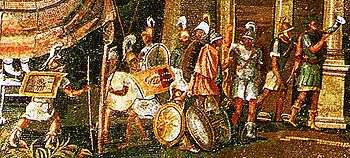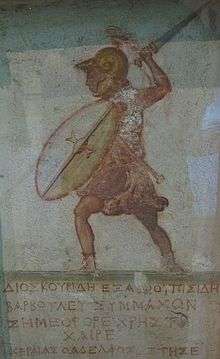Ptolemaic army

The Ptolemaic army was the army of the Ptolemaic Macedonian kings that ruled Egypt from 305 to 30 BC. Like most of the other armies of the Diadochi, it was very much Macedonian in style, with the use of the long pike (sarissa) in a deep phalanx formation. Despite the strength of the Ptolemaic army, evinced in 217 BC with the victory over the Seleucids at the Battle of Raphia, the Ptolemaic kingdom itself fell into decline and by the time of Julius Caesar, it was but a mere client-kingdom of the Roman Republic. The army by the time of Caesar’s campaigns in the eastern Mediterranean was a mere shadow of its former self: generally, a highly disorganized assemblage of mercenaries and other foreign troops.
The army of Ptolemy I

Ptolemy I was a general in the army of Alexander the Great and after Alexander’s death had taken over the province of Egypt as a satrap (local governor). Along with the other successors to Alexander he did not hold the title of king until 305, but was still an important player in the affairs of the Macedonian Empire in the east. In 312 BC at Gaza, Ptolemy, who was assisting the fugitive satrap of Babylonia, Seleucus I, came up against the forces if Antigonus I who was seen as a major threat to the stability of the empire due to his strength and power. Ptolemy had a force of 18,000 infantry and 4,000 cavalry, these being a mixture of Macedonians, mercenaries, and native Egyptians.[1] His forces were larger than those of Antigonus and his son, Demetrius Poliorketes. In the battle for Gaza, Antigonus’ cavalry, commanded by Demetrius, were initially successful but forced to retreat after Ptolemy out-flanked them. The battle was a victory for Ptolemy who soon secured Syria for himself and placed Seleucus in Babylonia to govern the eastern provinces of the empire. By 305 Ptolemy had taken the title of king, along with the other most powerful generals, including Cassander, Seleucus, and Antigonus. In 301 BC, the threat of Antigonus was finally ended with his death at the Battle of Ipsus. But despite this, the rivalry between the Ptolemies and the Seleucids for Syria would cause numerous wars in the future. The army under Ptolemy I was most likely composed of small Macedonian and mercenary garrisons left in Egypt by Alexander.[2]
The manpower problem
In the Ptolemaic era a small population of Greeks provided the main cadre of the army. These men provided manpower for the elite guards units and the phalanx that lay at its core. However, the distance of Egypt from Greece caused considerable difficulties as the population of Greeks in Egypt was and remained small. To remedy this problem, the Ptolemies set up military colonies and encouraged settlers to settle in them. In return for these plots of land, the kleruchoi, as they were known, would in return be obligated to provide military service.[3] Mercenaries were also employed by the Ptolemies, who could afford it due to their wealth. For example Ptolemy IV paid 1,000 drachmas a day for one distinguished Aetolian officer to serve in his armies.[4] This system gave the Ptolemies more manpower, however they still suffered severe shortages. Despite this lack of manpower, they would not allow native Egyptians to fight in the army proper. The natives would only serve in the navy or as auxiliaries.[5] This changed by the time of Raphia in 217 when the situation became especially dire for the Ptolemies. Their army was far too small to counter the far superior Seleucid force led by the formidable Antiochus III. To counter the larger Seleucid force, the general Sosibius assembled a large army which he trained for the fight to come, and in which he also enrolled 30,000 native Egyptians to serve in the phalanx.[6] These 30,000 picked Egyptians, known as the Machimoi Epilektoi, fought well in the battle, but caused problems later on. The increased status of these Egyptian troops enabled and encouraged them to revolt, which led to a further crippling of the kingdom in the years following Raphia.